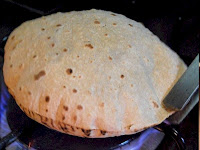Unveiling the secrets to crafting melt-in-your-mouth perfect chapatis
 In the hustle and bustle of our daily lives, we often find ourselves engaged in a multitude of activities, from deciphering the intricacies of our new mobile devices to meticulously refining our articles before sending them off to the editor. We invest hours brainstorming intriguing blog topics, but sometimes it's the simplest pursuits that capture our attention. For me, it all began with a simple question from my husband, "Well, the chapati is round today?"
In the hustle and bustle of our daily lives, we often find ourselves engaged in a multitude of activities, from deciphering the intricacies of our new mobile devices to meticulously refining our articles before sending them off to the editor. We invest hours brainstorming intriguing blog topics, but sometimes it's the simplest pursuits that capture our attention. For me, it all began with a simple question from my husband, "Well, the chapati is round today?"The Chapati Challenge
Despite having dabbled in chapati making since my school days, my culinary journey had left me with merely passable results. Being a devoted lover of Kashmiri cuisine, with its emphasis on rice, may have contributed to my initial struggles in perfecting this culinary art, especially after spending over two years in a Punjabi kitchen.
The Deceptively Simple Ingredients
On the surface, chapati-making seems uncomplicated, involving just two basic ingredients – flour and water. However, to achieve a high-quality result, patience and precision are essential from the very start. As I watched my mother, aunts, sisters, and mother-in-law effortlessly craft perfectly round chapatis, it appeared deceptively easy. Yet, whenever I attempted it, my efforts resembled little more than the amoeba diagrams I used to sketch in my biology class.
Chapati Making Masterclass
The process commences with the careful kneading of the dough, ensuring a harmonious blend of wheat flour and water to create a soft, pliable mass. This initial step is pivotal to the entire process. Following this, the dough is divided into small, evenly-sized balls, which are subsequently rolled into thin, circular sheets of raw chapatis. This is accomplished using a 'chakla' (rolling board) and a 'belan' (rolling pin). To prevent the dough from sticking to the rolling surface, a sprinkling of dry flour is employed. In the end, we are left with perfectly round (sometimes unintentionally!) sheets of raw chapatis, which are then expertly baked on a 'tawa.' The telltale puffing up of the chapati signifies a significant milestone in one's journey towards chapati perfection.
The Unattainable Softness
Today, I can certainly manage to produce round chapatis, but it largely depends on my mood and the time available. Yet, my chapatis are still a far cry from the melt-in-the-mouth softness of my mother's creations.
The Ongoing Pursuit
Until I can replicate those exquisite chapatis of my mother, I'll continue my culinary endeavors, eagerly awaiting the day when I can craft chapatis with such finesse. Perfecting the art of chapati-making is a journey of patience, practice, and persistence. It's a delightful pursuit that teaches us that even the simplest things can be the most challenging. As I continue to strive for culinary perfection, I look forward to the day when I can proudly serve up chapatis as soft and round as those crafted by the women who inspire me.


Comments
Post a Comment